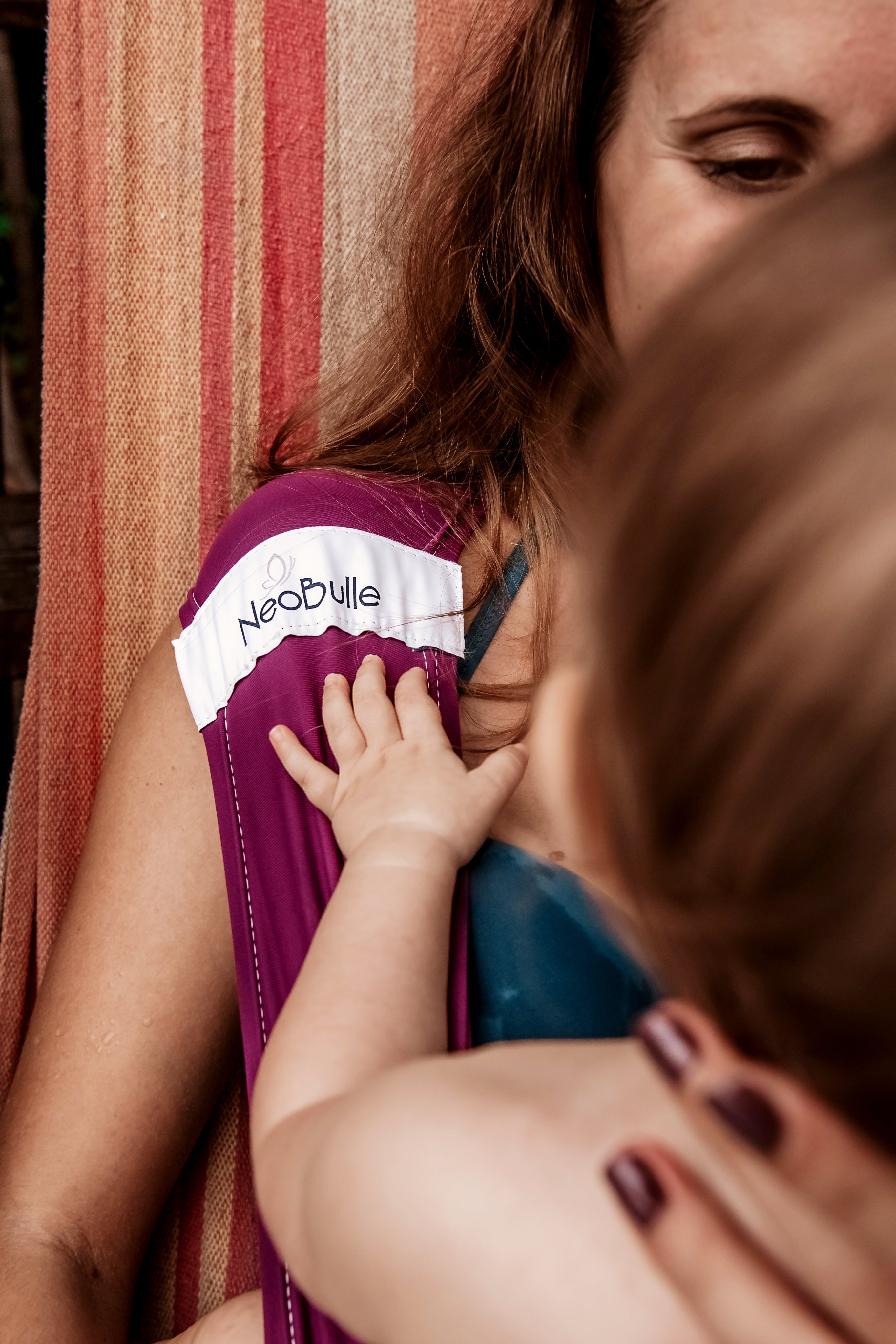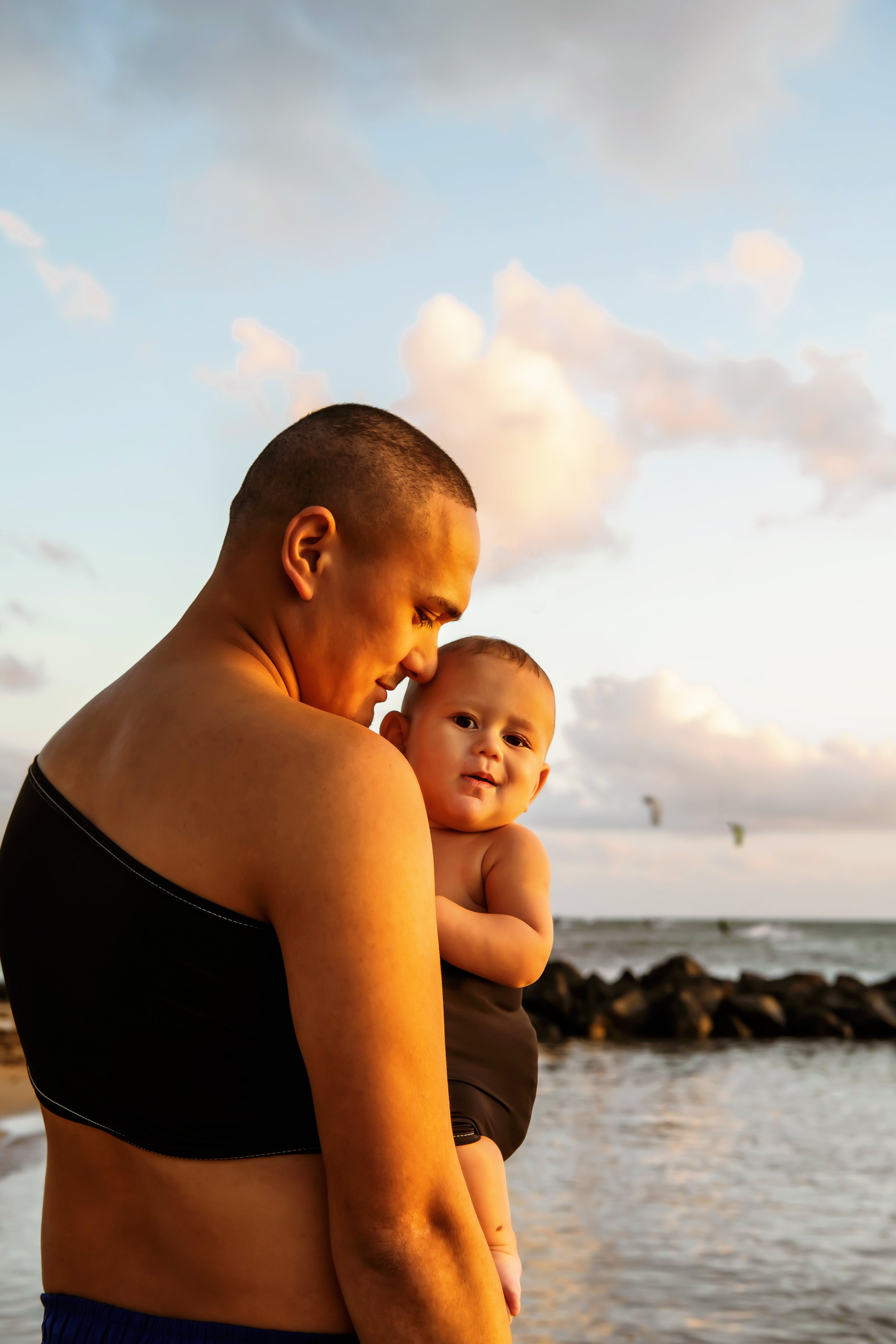
Baby carriers and breastfeeding: all our advice
Is breastfeeding in a baby carrier really possible? The answer is yes, a thousand times yes—and it's actually a valuable practice, both for the baby's well-being and the parent's comfort.
Co-parenting: much more than just a practical gesture
What could be more magical than feeling that little body all curled up against you? Maybe you've already experienced skin-to-skin contact at the maternity ward. That suspended, intense moment when the bond is woven to the rhythm of heartbeats.And what could be more natural to create a deep attachment between you two, as you are still discovering each other... Even if you've always been there, by their side, whispering sweet words through their mother's belly, you have to admit: she has a nine-month lead.But rest assured: carrying your baby is a wonderful way to catch up on this time, to build your bond at your own pace, gently and with closeness. A physical and emotional connection Carrying your baby means physically feeling the fullness of having them against you. Their body curled on your chest, rocked by your breathing, your heartbeat, your movements. Because yes, as soon as the baby is against you, your body naturally begins to sway.Seeing them fall asleep against you, letting go in complete trust... and feeling, yourself, becoming a parent. More and more competent, more and more connected to their essential needs: contact, movement, attention, security. Carrying helps calm their cries, soothe their fears, support their natural development. And, little by little, they will no longer just fall asleep against you, but will discover the world... your world. Safely, in this caring "pocket" that allows them to explore without being jostled, at their own pace. Much more than a practical solution Yes, carrying your baby allows you to have free hands. Yes, it's practical for walks, errands, falling asleep. But above all, it is a deeply instinctive and nourishing gesture.Unlike other mammals, human babies do not know how to move around at birth. They need to be carried. This is how they feel safe, how they develop their body, their brain, their five senses... and much more.Some babies demand a lot, others less. But all fundamentally need it. Otherwise, nature would have planned things differently. A carrying method that suits you All that's left is to find the carrying solution that suits you: according to your desires, your morphology, your daily life. The key is that you feel comfortable, autonomous, and confident in placing your baby in it.For that, don't hesitate to contact a carrying instructor. They are professionals trained in physiological carrying. They will teach you much more than knots: they will give you valuable keys about babies' needs, and help you find the most suitable solution for your duo.At Néobulle, we believe that carrying is a wonderful tool to strengthen the parent-child bond, support the baby's development, and allow each co-parent to find their place, naturally.Do you have a question or want to share your experience? Join our community or contact our carrying advisors.
The role of the co-parent during breastfeeding: an essential pillar
Breastfeeding is much more than just a nourishing act: it is a bond, a mission, a total immersion.
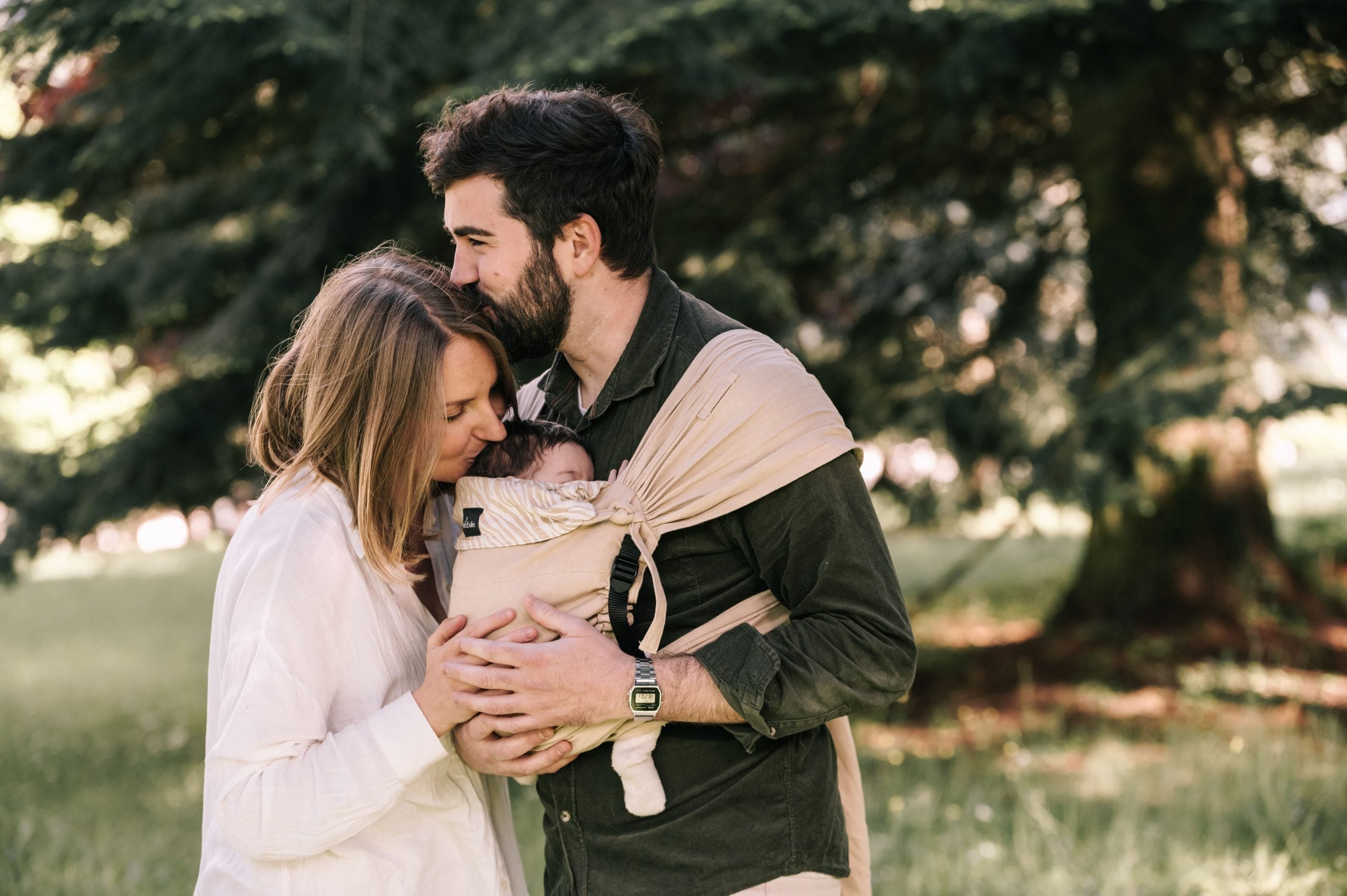
The role of the co-parent during childbirth: presence, support, and shared magic
The presence of a co-parent during childbirth has become a given for many. This intense moment, both physical and emotional, is no longer experienced alone.
8 good reasons to get cuddles!
Cuddles, kisses, snuggles, and sweet moments… Do we really need excuses to enjoy these tender moments with our loved ones? We know the answer is no. But because sometimes we feel a little guilty about asking for a little bit of love from our little one and because he is tough to negotiate with, here is a list of 8 excuses, to help you feel good about it! Good reason to indulge in number 1: it's good for morale! About 10 seconds of cuddling releases several hormones: oxytocin, endorphins, and dopamine, which are involved in the processes of pleasure, attachment, and well-being.Giving a cuddle is not just a hug, it's happiness on a stick, it's SCIENTIFIC, and you can't fight against science… Good reason to cuddle number 2: it smells good Hmmm the sweet smell of our children's skin… A real drug, isn't it?While we hold them close to us, we can discreetly enjoy sniffing their skulls or necks and be intoxicated by their gentle baby scent.Let's enjoy it before they grow up and adolescence and its hormones come into play! Good reason to cuddle number 3: it’s good for self-esteem When we kiss and pamper our children, we help them feel loved. This contributes to their self-esteem and helps them trust themselves.We will be OBLIGED to cover them with cuddles, so it's for their own good! Good reason to cuddle number 4: it regulates temperature Physical proximity helps to regulate body temperature. It’s ideal forCooling down when it’s hot in the summerWarming up when it’s cold in the winterWhat a joy to all snuggle under the blanket when it’s cold outside for a family maximum cuddle!Bonus: it also works in baby carriers! Good reason to cuddle number 5: it boosts the immune system Did you know?Researchers from a university in Pittsburgh have demonstrated that people who receive more cuddles on average during a day are statistically more resistant to colds and less severely affected. They hypothesized that hugs would improve antibody levels.Admit it, that’s dreamy!Neobulle Bonus: how about pairing this little boost with a massage using Atchoum oil? Good reason to cuddle number 6: it reduces blood pressure Enjoy a sweet moment with a loved one releases oxytocin and contributes to relaxation and overall stress relief. All of this helps to reduce stress, heart rate, and blood pressure.General tour of free hugs, it's good for health! Good reason to cuddle number 7: it allows you to rest Isn't it nice there, relaxed, snuggled on the sofa with our little ones against us? Their chubby little fingers fiddling with our arms… Their regular breathing rocking us… Our too short nights painfully remembered, and our eyelids becoming heavier and heavier…With a bit of luck, they will fall asleep with us and it will be an opportunity for a collective nap! Good reason to cuddle number 8: after that, they will be too big! Growing up is big but somewhere, deep inside us, we know it… One day our children will be grown up, they will go to middle school (and even high school), and we will no longer have permission to approach within 200m of the school, so cuddling in front of friends?! Too embarrassing!So, we should enjoy it as much as possible and make the most of it while they still ask for cuddles!(It’s not something you should say too loudly but honestly, at home, away from prying eyes, without telling friends, a little cuddle with mom really isn’t so bad!) So isn’t that pretty awesome? Don’t hesitate to share all the superpowers of cuddling around you by letting your loved ones enjoy it too!
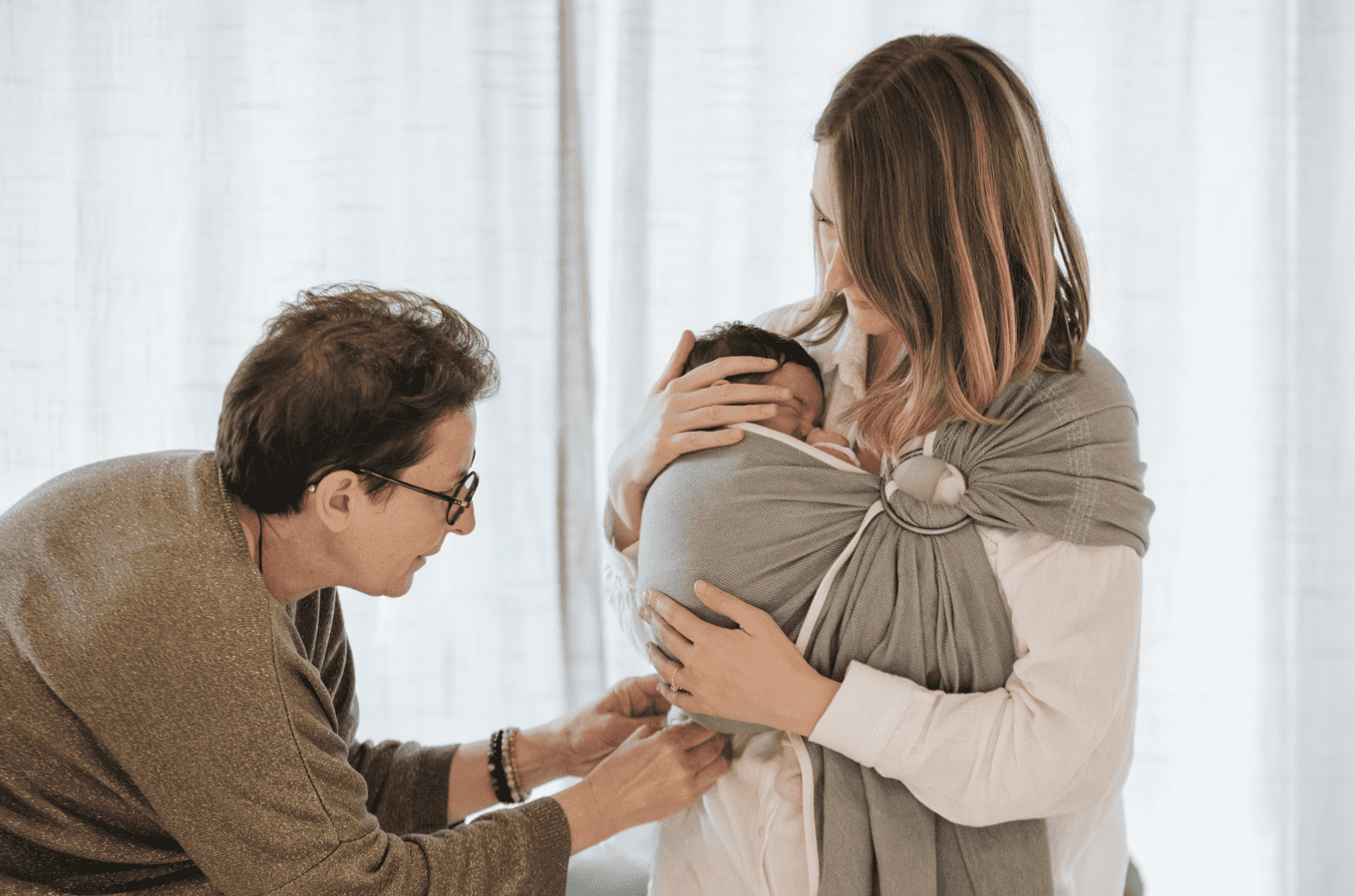
Carrying a baby with hip dysplasia
Hip dysplasia is a condition that affects a non-negligible proportion of newborns and is characterized (in simple terms) by impaired development of the joint and a poor positioning of the femoral head within the hip socket. Without causing pain to the child, it still requires management to prevent later complications. In this context, the question of carrying is quite common: can you carry your baby despite the braces? Is there a risk of worsening the condition? 1 – A baby carrier, yes, but not just any When hip dysplasia is suspected in an infant (or has been confirmed), the recommendations are to ensure that it is handled by avoiding as much as possible traction and extension positions of the leg, in order to maintain as much as possible the correct position of the femoral head in the hip socket. The proposed therapy is often carried out using bracing devices that aim to stabilize the leg in an appropriate axis and that, with time and the child's growth, the hip develops back to normal. The posture induced by orthoses is a combination of abduction (opening) and flexion of the thighs (knees also being flexed and spread apart). Considering all this, it appears that the recommended positions for physiological carrying, notably with a slightly open pelvis and knees raised higher than the hips, are quite similar to those induced by the braces used to treat dysplasia.Non-physiological carrying , characterized notably by a suspension by the crotch (narrow seat) and unsupported leg that "hangs", are on the other hand contrary to the intended goal.Whether by arm or with the help of a baby carrier, carrying a baby presenting hip dysplasia is always possible but only if it helps stabilize the hips in flexion and abduction, which will be the case if the baby carrier is physiological. 2 – Baby carriers and braces for dysplasia The biggest difficulty usually encountered is to reconcile the implementation of carrying with the presence of the orthosis. Several configurations are possible:The device can be removed a few hours a day: the baby carrier can then simply be used as usual during the "free" periods, which also allows for continuity of treatment by maintaining good postures longer.The device should never be removed: in this case, it will be necessary to adjust the setup to be able to use the baby carrier without compromising the treatment. Depending on the device used, the recommendations and adjustments will vary. The soft abduction diaper One of the simplest cases is that of the soft abduction diaper (also often called "cocoon" or "cocooning" diaper), as it is less prone to errors. The setup is the same as when carrying a baby without any brace, except that the little one will have more spread legs. The correct position is already provided by the diaper, the baby carrier simply fits around it. With an abduction diaper, due to its rigidity and the fact that it extends high on the baby's belly, it is not possible to achieve a pelvic tilt and a well-rounded back.With a wrap, you can opt for dynamic "plate-like" tying methods, such as the crossed swaddle for example. With a mei-tai or a preformed baby carrier, you can possibly widen the seat slightly to accommodate the more pronounced opening of the legs. With a sling, it is best to prioritize an installation as ventral as possible so that the carrier's abdomen maintains proper hip opening (on the hip, the opening is insufficiently pronounced).Be careful to check that the baby carrier does not compress the baby's leg at the level of the diaper (mainly with wraps and slings). If there is difficulty on this point, you can pad the fabric on the edge of the diaper instead of reaching for the hollow of the knee. The Pavlik Harness The Pavlik harness, being more flexible, is often less bothersome than the diaper at the material passages and is more conducive to pelvic tilt. However, you must be very rigorous with the installation to ensure the abduction position is well maintained, since this time, the device will not correct it on its own. Displaced carrying methods are not recommended with this system for this reason. Some children are sometimes clumsy; when this is the case, the baby carrier installation mainly requires ensuring that the position does not cause chafing or injuries and irritations. It may also cause discomfort for the wearer.In all configurations, substituting a period of orthosis wear with a period of carrying cannot be done without prior medical advice. 3 – label "international hip dysplasia institute" The International Hip Dysplasia Institute is a non-profit organization that works to prevent, diagnose, and treat hip dysplasia, aiming to improve the health and quality of life of children and adults with hip dysplasia. To this end, the organization has developed a certification label indicating that a product is safe for proper hip development. Baby carriers bearing this label guarantee that their design preserves the baby's hip joint; this is a useful mention when there is doubt on the subject. This label presents some limitations. Since it is a paid, expensive, and non-mandatory certification, the absence of the label does not necessarily mean that a baby carrier is unhealthy for the hips but sometimes just that the brand could not or did not want to perform the appropriate tests.Moreover, it is important to distinguish between the notions of hip preservation, carrying physiology, and safety.A baby carrier that keeps the femur in the correct axis but does not allow a good close body contact between the child and the parent nor a proper rounding of the baby's back is thus OK from a hip perspective, but not at all from a physiological and comfort standpoint (spread legs and straight back, it’s better than dangling legs but not very comfortable either).Similarly, the safety of the baby carrier is completely independent of the notions of hip physiology and posture. Carrying systems from the different ranges of neobulle have all been designed to allow proper development of the hips of very young children while respecting their physiology and safety. They all display or nearly all display the international hip dysplasia institute label and will allow you a comfortable carry for both your baby and yourself, with peace of mind.If your baby is at risk of developing hip dysplasia or has already been diagnosed with it, the use of all our tools is possible.Do not hesitate to contact a carrying instructor to help you choose the model, install it, and adjust it according to your specific situation!

What to do with a baby carrier blanket?
Congratulations! You are now the proud owner of a 3-in-1 carrying cover !Did you know? Even if you bought it to use with your baby carrier, it can be used in many other configurations… some of which are quite unexpected!Here are some ideas? 1 – On a baby carrier Classic, effective… The standard use of a carrying cover is still being able to use it while carrying your baby! We’re not teaching you anything.Universal, it can be used on all types of carriers, regardless of the brand or system! It has adjustable cords that allow you to fit it to your baby’s size so that cold air doesn’t rush inside. Details that matter: polar fleece flaps to slide your little one’s feet inside, and a lined pocket for the parent’s hands, to be able to stroke their back protected from the icy wind.Isn’t it nice to be warm and cozy with your little one cuddled against you, while temperatures drop outside? 2 – In a car seat Quick, keep the warmth chain going by placing your little one and their cover directly in the car seat. A designed opening allows you to pass the strap between their legs, attach it, fold the sides over them, and go! 3 – In a stroller In a 3-point stroller, you can use it like in the car seat, or when they’ve grown enough and their little legs are the size of the cover, you can simply lay it over the child and secure it to the frame with Velcro. They will stay warm and protected from the wind throughout the walk. 4 – A picnic blanket A little picnic or snack outdoors… but the ground is a bit too damp? The cover can help protect you! Its outer layer in water-resistant softshell is an excellent insulator, and even if it gets a bit dirty during use, it’s easy to wash in a 30°C machine.Escape is saved! 5 – A makeshift umbrella Oops, it starts to rain a little and you haven’t planned for an umbrella… Luckily, the cover is large enough to shelter two underneath and serve as a makeshift umbrella!Saved, you won’t arrive at work completely soaked! 6 – A makeshift coat for the toddler A somewhat hasty departure where everyone thought the other had taken miss deuzans's coat, and here you are arriving on the scene... without the famous coat, which stayed at home! It happens even to the best.The blanket as a DIY poncho and off you go for the family outing! 7 – A bag for collecting chestnuts What luck to find all these chestnuts during this little walk in the forest! Pity that you don't have a bag to gather them... Unless you use the blanket?Quick, pull the adjustment cords here and there, and that will do the trick...Yum, the tasty snack! 8 – A superhero costume You probably didn't know, but it's not just a simple carrying blanket... It's primarily a superhero cape allowing your toddler to take on their secret superhero role of masked super-justice warrior!But shhhht!!!! It's a super-secret!!!! Of course, this list is not exhaustive! And you, how did you use your carrying blanket?

Dry skin and baby: what to do to hydrate your baby's skin in winter?
Cold, heating, and pollution are all assaults on your little one's fragile and sensitive skin. The consequences are quick to appear: it turns red, dries out, irritates... And even if you use tons of cream, it seems that your little heart slowly but surely turns into a crocodile.So what can you do to hydrate your baby's skin in winter? Here are our little tips! Why is my baby's skin dry in winter? Winter, we all know that our skin is vulnerable, and it's also the time when we pull out very rich creams for the face or hands and sticks for chapped lips, but why? Due to our cold and dry climate, ambient humidity decreases significantly. The air then draws moisture from our skin, which dehydrates and weakens. We observe the same phenomenon inside our homes where heating also dries out the environment considerably.In parallel, when it’s cold, the body tends to prioritize the functioning of vital organs, leaving a bit of the epidermis aside... Sebum production is slowed down, body energy being mobilized for more essential functions. Think of sebum as a small greasy film that protects the skin by helping it retain water inside. Without this film, the skin evaporates more easily, which further facilitates dryness of the epidermis.You understand, if these mechanisms apply to you, they are also certainly true for your little ones! Additionally, rubbing certain clothing, the tine creating a maceration zone around the mouth which is also conducive to irritations, and skin that is much more fragile than that of adults, and therefore more sensitive to all aggressions. Limit skin aggressions on my baby Since it is not always possible to expatriate to latitudes with more temperate climates to escape the cold, what can we do daily to protect our baby's skin?One of the simplest actions to implement first is to limit baths. Indeed, baths tend to weaken the epidermis (notably by disrupting the hydrolipidic film that protects it) and to dry it out. This is especially true when your region's water is hard. A bath every 2 to 3 days (or more if your little one has very reactive skin or eczema) is more than enough, as long as the only 'dirty' areas (like the diaper area) are already cleaned at each change.It is recommended that the water used is not too hot (between 35 and 37°C) and that the bath remains short (10 minutes maximum). For drying, gently pat with a very soft towel (link to cocoon bath) (avoid rubbing) while giving a big cuddle to your little heart to help evacuate remaining water without irritating. Regarding skincare products, generally it is important to pay attention to the ingredients of cosmetics used on the skin of your little ones. Many ingredients can be very irritating and cause redness and inflammations.We recommend that you prefer simpler formulas, containing few ingredients, hypoallergenic, ideally natural and organic, and suitable for the specificities of children's skin.Clothing can also be adapted to preserve as much as possible the sensitive skin of your little one: ditch the synthetic which heats, rubs, and dries out! Opt for natural materials… Soft cotton first and foremost. And why not test merino wool or wool and silk blends? Wool and silk have thermoregulatory virtues perfect for winter, keeping baby warm and cozy without making them sweat, which is appreciated since sweating can also irritate the skin! Nourishing and rehydrating my baby's skin: which products to use? Fat is life! As we have seen, the skin no longer produces sufficient sebum, so now is not the time to hesitate on quantities, you can generously spread it on your little one until they shine!For washing, the most sensitive skin can appreciate a gentle, extra-rich soap at 8% without any perfume or additives. Rich in glycerin, it leaves the skin soft and nourished.For families preferring the gel format, the Bubble Baby Gel offers a pH that is physiologically compatible with the skin and contains no sulfate surfactants. Are you breastfeeding your baby? Do not hesitate to express some of your milk into the bathwater to offer a real moisturizing treatment to your little one (like Cleopâtre and her milk baths). If you have bottles of milk that are unsuitable for consumption, it is a good solution to avoid wasting them.Right after getting out of the water, while the skin is still a little damp, we invite you to massage your child with a neutral massage oil that will penetrate the epidermis well, for enhanced hydration. It’s also a perfect moment to share a moment of tenderness with your little one!For the facial skin and hands, which are more directly exposed to wind and cold. and on which we often find red and dry patches (especially on the cheeks, or around the mouth when the scalp creates a zone of friction and maceration), we can apply treatments more repeatedly, ideally morning and evening. You can choose based on texture preferences:Soothing skin cream : a rich and nourishing cream, made with organic shea butter, calendula, and fine lavender essential oil. Ideal for soothing irritations and redness. From 3 months old.Aloe Caresse Gel : a gel with a fluid, non-greasy texture, which hydrates and regenerates the skin. From birth.Want to learn more about our Aloe Caresse Gel? Don’t hesitate to check out our article on the benefits of aloe vera for the whole family.Generally speaking, don’t hesitate to take advantage of diaper changes to apply a bit of liniment or oil (or your milk!) on the rest of your baby’s body, everything helps, and their skin will thank you!You now know everything! Grab your cream and oil bottles, what a perfect excuse to give lots of massages and cuddles to your little ones!
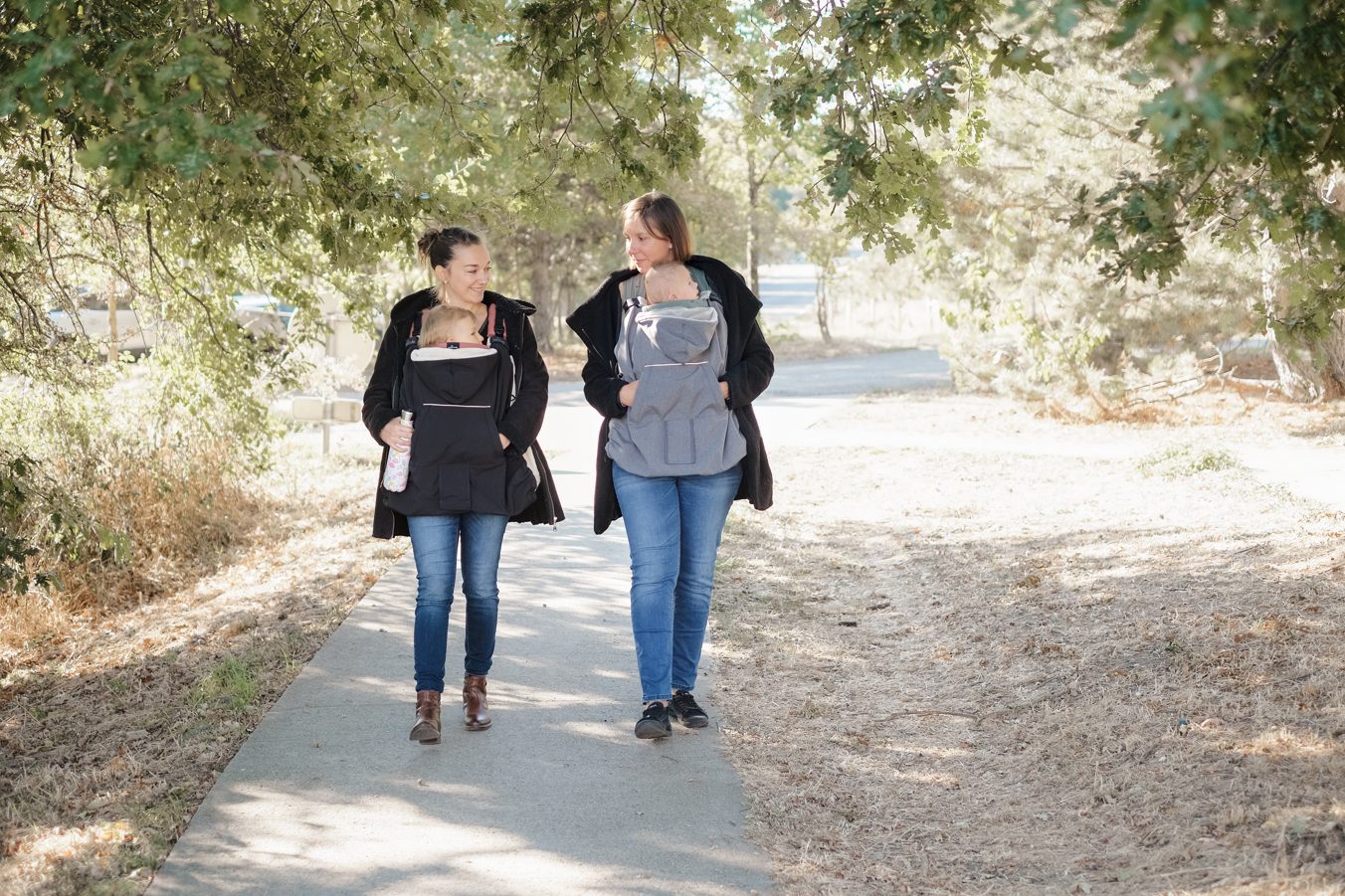
Properly cover the baby in a carrier during winter
Winter is coming… Even though you've explained in the article on "How to protect your baby from winter viruses" that a poor outfit won't make your little one sick, you still fear that he might be cold.Is he sufficiently dressed? Or on the contrary not enough? How to ensure that your baby has enough warmth in his stroller during winter? Shall we take stock together? Why wear warm clothing in winter? Generally speaking, wearing turns out to be more practical on a daily basis, and this is even more true when winter is beginning. Winter means cold and bad weather… Ah the joys of the stroller and its rain cover with obscure installation, which leaves us completely perplexed (and soaked!): we never know which way this thing goes! And anyway, except for some models, the stroller requiring 2 hands to maneuver, it rules out using an umbrella to shelter yourself. Does that sound familiar?More generally, the farther away your baby is from you, the harder it is to assess his comfort. When you carry him, he is in your contact and it’s easier to make sure he has adequate warmth regularly and to know how to dress him.Finally, some activities are simply incompatible with using a stroller. Going away for the weekend to the mountains? Wheels and snow don’t mix well, for example. Covering baby in his carrier system… To keep his baby warm enough, one might be tempted to wrap him up in a snowsuit or thick clothing and a big coat. In fact, this is the first reflex most people will have to protect their little one from the cold.Totally counter-intuitive, it is actually the opposite of what is recommended.Why?The thickness of clothing affects the proper fit of the baby carriers, making carrying uncomfortable and potentially less safe.It can also compress the joints and hinder proper blood circulation in the legs, as well as obstruct breathing.It keeps your baby away from your body, which prevents the thermoregulation mechanisms from working properly and modulating heat according to his needs: he will suffer more easily from the cold.We also add that if you place your baby over your coat , in addition to being very uncomfortable and feeling particularly constricted in your jacket, the buttons or decorations on it could hurt your little one. For a baby carrier, it is therefore recommended to dress your baby normally, as if indoors. The carrying system counts as an extra layer of clothing (if outside of carrying your baby was wearing a small jacket, for example, the carrying scarf will replace the jacket). Your little one thus benefits from the thermoregulation of your own body, which helps him stay warm against you.It is also advised to cover what extends from the baby carrier and is more likely to get cold: a hat for the head, leggings and booties for the legs. Hands are generally tucked between him and you and your baby would hardly appreciate not being able to put them back in his mouth at will, so let’s leave them alone! … and wrap yourself in a cozy blanket Once your little one is dressed (normally, then) and settled in his baby carrier, the wearer can put on their usual coat and wrap their baby in a soft carrying blanket! The carrying blanket allows you to naturally retain the warmth generated by your body and that of your baby, like inside a bubble. No risk of suffering from the cold! Our blanket also features a windproof and water-repellent softshell layer, preventing icy air from seeping into the clothing and causing an unpleasant sensation.Essential for winter, it adapts to your daily needs. You go into a store? Just detach it to reveal your little one and avoid him getting too hot during shopping.Universal, it attaches to all baby carriers and can be used just as well by mom or dad.Is it REALLY cold? If the temperatures become very very low, around -10°C, -15°C or even less, don’t hesitate to opt for woolen clothing, or a blend of wool and silk. Very thin and flexible, they thermoregulate and can pleasantly complement your little ones’ winter outfits. Rest assured, merino wool has nothing to do with the wool of our childhood: it is soft and doesn’t itch! What to watch for when carrying your baby in winter? Despite these little tips do you have some concerns? Don't panic! We provide you with a small checklist of points to watch during the walk:Clear respiratory pathways: even if it's cold, breathing well is always a priority! Resist the temptation to pull up coats and blankets behind the little ones’ heads, not higher than the neck, and their face should remain visible.If the walk lasts longer, regularly move the extremities and possibly massage them a bit, to properly activate blood circulation.Is it freezing cold? Maybe it's better to shorten the hike! Remember that if you warm up when walking because you are active, your baby is passive in their carrying system and may get cold if external conditions are too harsh. And outside of carrying, how to cover the baby? Did you know? It’s not just in carrying that thick clothing is prohibited, it’s also in car seats!To stay well protected in case of shock, your baby needs to be securely held in the seat, so the straps should be relatively tight on them (they shouldn’t be pinched). If they are wearing a coat or a suit, the straps will be adjusted not on their body but on the padding. In case of an accident, this padding will flatten, and since the straps can no longer do their job, the baby risks being ejected.By the way, in a car there is heating, after the first few minutes after departure, it generally feels good and the suit is no longer really necessary!Again, the 3-in-1 blanket is a good asset: placed at the bottom of the seat, it has an opening designed to pass the straps, which will allow you to attach your little one, then if necessary, fold it over them until the temperature rises enough in the cabin to uncover them.In a stroller, it’s up to you to choose between blanket/footmuff and suit! The suit has the disadvantage of considerably restricting your child's movements, while the footmuff is less covering. If you have both, don’t hesitate to test to see what your little one prefers. The cold can arrive, are you ready to face it?
